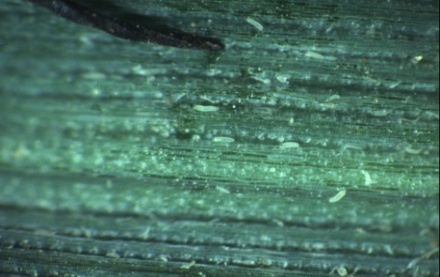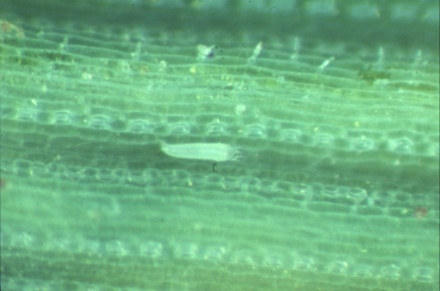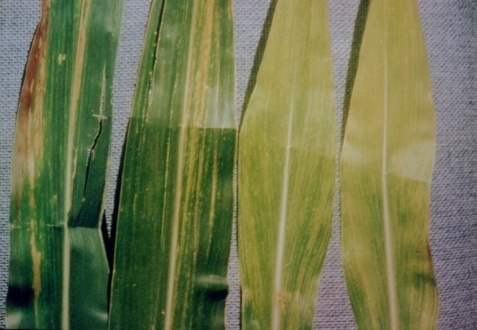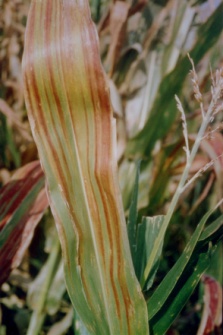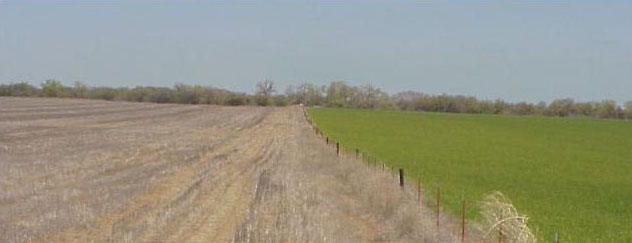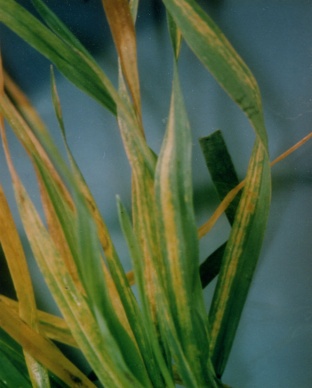Wheat Streak Mosaic and High Plains Virus
Introduction
Wheat streak mosaic virus (WSMV) and high plains virus (HPV) infect wheat, corn, and many other grasses. The diseases caused by these viruses have been observed primarily in the drier areas of Oklahoma, i.e., the panhandle and western OK. Both viruses are transmitted by the wheat curl mite (Fig 1.), and can cause significant losses in wheat and corn especially if the host is infected early in its development.
Figure 1. Wheat curl mites on leaf surfaces.
Wheat curl mites viewed at 10X magnification.
A single wheat curl mite viewed at 63x magnification.
The wheat curl mite (WCM) is tiny (1/100 inch long), sausage-shaped with two pair of legs and can best be seen with the aid of a 20X magnifier. They are usually found in protected areas of the host plant such as a curled leaf, a leaf whorl, or between leaf veins. They infest wheat, corn, barley, oats, and foxtail millet, as well as grass hosts including jointed goatgrass, sandbur, and Canada wildrye. WCMs can increase rapidly when conditions are favorable, going from egg through two nymphal stages to adult in as little as 8-10 days at 780F. WCMs rely totally on air currents to move from plant to plant, floating much like dust particles.
Figure 2. Symptoms of high plains virus in corn. (Photos courtesy of Dr. Stan Jenson, Univ of Nebraska).
Infection
WCMs obtain WSMV or HPV (Fig 2.) by feeding on infected wheat, corn, or grasses. Once infected, mites spread to commercial wheat or corn by air currents and transmit the virus to that commercial host.
Figure 3a. April 2004. Left of photo: Volunteer wheat; sprayed with Round-up in March. Right of photo: Commercial field.
Figure 3b (left) & Figure 3c (top): up-close views of wheat streak.
WCMs infected with WSMV and/or the HPV typically originate in volunteer wheat, corn, or grasses, which spread to fields of commercial wheat or corn on wind currents (Fig 3a.). WSMV symptoms in wheat include clearly visible streaks (Fig 3b.). In addition, yellowing, desiccation and leaf death (Fig 3c.) are commonly associated with HPV or mixed HPV plus WSMV infections. Both viruses can cause severe yield losses as indicated for WSMV (Table 1).
Table 1. Losses caused by wheat streak mosaic virus (WSMV).
| Wheat variety & time of infection | WSMV severity (0-3)A | Yield (bu/acre)B |
|---|---|---|
| Chisholm – fall infected | 2.7 | 19* |
| Chisholm – spring infected | 1.3 | 42* |
| Chisholm – not infected | 0.0 | 51 |
| Tam 108 – fall infected | 1.7 | 25* |
| Tam 108 - spring infected | 0.7 | 48 |
| Tam 108 – not infected | 0.0 | 63 |
| Siouxland – fall infected | 3.0 | 14* |
| Siouxland – spring infected | 1.0 | 40* |
| Siouxland – not infected | 0.0 | 41 |
ASeverity rated on a scale of where 0=no symptoms, 3=severe symptoms of WSMV.
BValues followed by an asterisk differ significantly from the “not-infected” treatment.
Management
Controlling WSMV & HPV is related to limiting WCM infestations. Hence, a later planting date and destruction of volunteer wheat and/or corn reduces the chance of mite infestations. Since mites have a short life span, destruction of volunteer wheat or corn for 14 days or more prior to emergence of seedling wheat is imperative to help limit infections of wheat with WSMV and/or HPV in the fall.

